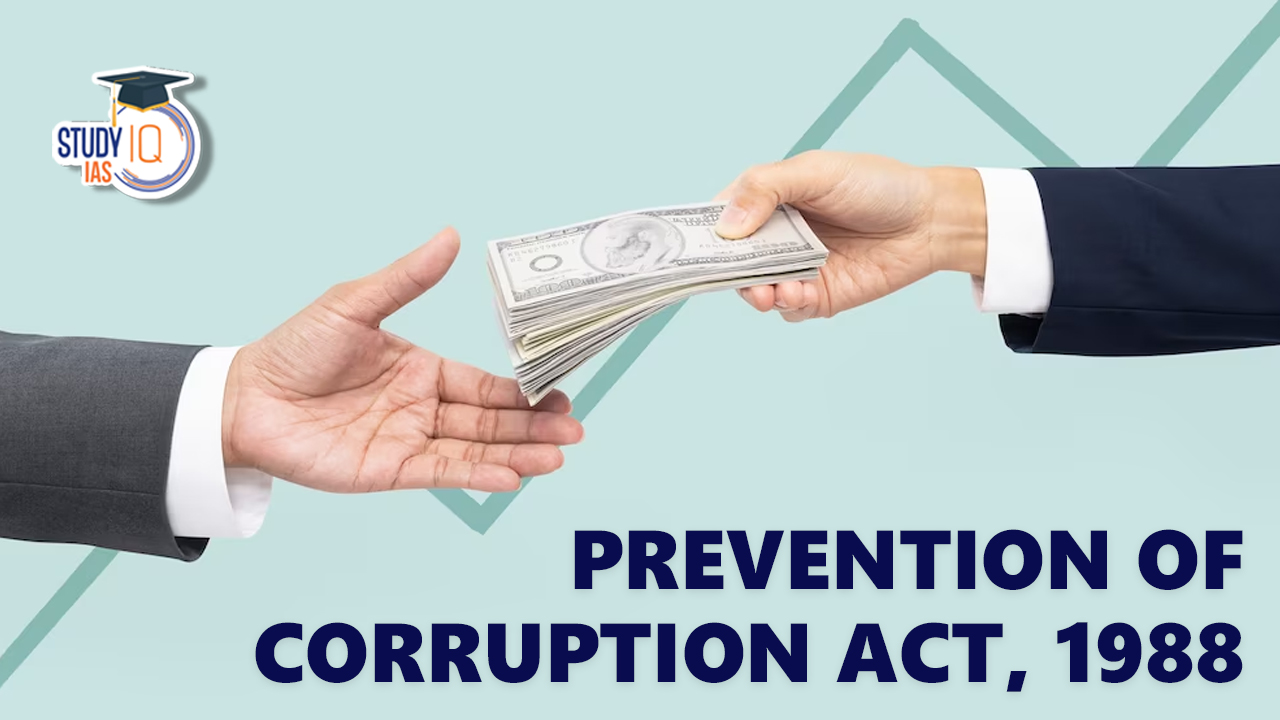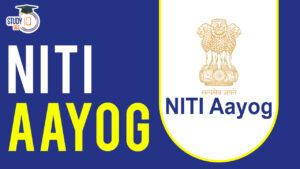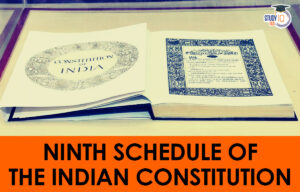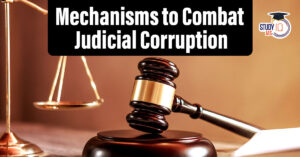Table of Contents
Prevention of Corruption Act, 1988
Corruption has been a serious problem in India for a long time, mainly caused by leaders who take advantage of situations for their own benefit. This issue hinders progress, especially in developing countries like India, and impacts many areas, including education.
One of the first laws to fight corruption was the Criminal Law (Amendment) Ordinance of 1944, which aimed to stop the selling or hiding of property gained through illegal means. In 1964, the Central Vigilance Commission was set up to specifically deal with corruption, along with similar commissions in various states.
To improve the fight against corruption, the Prevention of Corruption Act, 1988 (POCA) was created. This law brought together existing rules and focused on corrupt actions in government. It is crucial for punishing public officials who engage in corruption and allows the Central Government to appoint judges to handle these cases.
Read about: Law Commission of India
Evolution of Corruption Act
The Indian Penal Code of 1860 initially addressed bribery and corruption involving public servants, but it was found lacking by the 1940s. To tackle this issue, the Prevention of Corruption Act was introduced in 1947. This Act was amended twice:
- first in 1952 and
- then in 1964, based on recommendations from the Santhanam Committee.
The 1947 Act laid the groundwork for the Prevention of Corruption Act of 1988, which became effective on September 9, 1988. This updated Act aimed to strengthen anti-corruption laws, making them more effective in combating corruption in government and public sector organizations.
The Act not only focuses on detecting corruption but also emphasizes prosecuting and punishing public servants involved in corrupt activities. It also addresses those who assist in committing these offenses.
Prevention of Corruption Act, 1988 Objectives
As per the provisions of the Prevention of Corruption Act, 1988, the objectives of the act can be summarized as follows:
- Preventing Corruption: The act aims to prevent corrupt practices by establishing a legal framework that criminalizes bribery, abuse of public office, and illicit enrichment.
- Promoting Transparency and Accountability: The act seeks to promote transparency and accountability in public administration by requiring public servants to disclose their assets, liabilities, and financial interests.
- Deterrence and Punishment: The act aims to deter individuals from engaging in corrupt practices by imposing strict penalties, including imprisonment and fines, on those found guilty of corruption offences.
- Investigating and Prosecuting Corruption Cases: The act provides for the investigation and prosecution of corruption cases, outlining the procedure for gathering evidence, conducting trials, and ensuring a fair and expeditious legal process.
- Protecting Whistleblowers: The act recognizes the importance of whistleblowers in exposing corruption and provides protection to individuals who report corruption-related offences in good faith.
- International Cooperation: The act enables international cooperation in the fight against corruption by facilitating the exchange of information and mutual legal assistance with other countries.
- Asset Recovery: The act includes provisions for the identification, seizure, and confiscation of the proceeds of corruption, aiming to deter individuals from benefiting from their corrupt acts.
- Preventive Measures: The act emphasizes the need for preventive measures to combat corruption, including establishing vigilance commissions, promoting awareness, and educating public servants and citizens about the detrimental effects of corruption.
Also Read: Right to Information Act
Prevention of Corruption Act, 1988 Salient Features
The Prevention of Corruption Act 1988 in India encompasses several salient features aimed at combating corruption. Some of its notable features include:
| Feature | Details |
| Definitions | The act defines various terms related to corruption, such as public servant, bribe, gratification, and undue advantage, to provide clarity and specificity in identifying corrupt practices. |
| Criminal Offenses | The act criminalizes the act of accepting bribes, offering bribes, and using influence or illegal means to obtain an undue advantage. It covers both the giver and receiver of bribes, ensuring a comprehensive approach to tackling corruption. |
| Prosecution and Penalties | The act outlines the procedure for the investigation, prosecution, and trial of corruption cases. It provides for stringent penalties, including imprisonment and fines, for individuals found guilty of corrupt practices. |
| Public Servants | The act places specific responsibilities and obligations on public servants, including the requirement to disclose their assets, liabilities, and financial interests. This provision aims to enhance transparency and accountability among public officials. |
| Prevention Measures | The act emphasizes the need for preventive measures to curb corruption. It includes provisions for establishing special courts for speedy trials, creating vigilance commissions to investigate corruption cases, and promoting awareness and education to discourage corrupt practices. |
| Extraterritorial Jurisdiction | The act extends its jurisdiction beyond India’s borders, allowing for the prosecution of Indian citizens involved in corrupt practices abroad. |
| Whistleblower Protection | The act provides protection to whistleblowers who report corruption-related offenses in good faith. It safeguards them against victimization or retaliation, encouraging individuals to come forward and expose corrupt activities. |
| International Cooperation | The act facilitates international cooperation in the fight against corruption by enabling the government to enter into agreements with other countries for the exchange of information and mutual legal assistance. |
Read about: Uniform Civil Code
Prevention of Corruption Act in India
The performance of the Prevention of Corruption Act in India has witnessed several important landmarks, showcasing the nation’s commitment to combating corruption. One crucial milestone is the establishment of the Central Bureau of Investigation (CBI) in 1963, which investigates corruption cases under the Act.
Over the years, the Act has undergone amendments to strengthen its provisions, with the 2018 amendment introducing stricter measures to tackle bribery and extending the Act’s scope. Landmark corruption cases such as the Bofors scandal, the 2G spectrum case, and the Coalgate scam have shed light on corruption issues, leading to investigations, prosecutions, and convictions, thereby underscoring the Act’s role.
The Whistleblower Protection Act, 2014, has provided protection to individuals exposing corruption, encouraging their active participation in anti-corruption efforts. International cooperation in combating corruption has also been strengthened, with India signing agreements for mutual legal assistance and actively participating in global forums like the United Nations Convention against Corruption (UNCAC).
The establishment of the Lokpal and Lokayuktas through the Lokpal and Lokayuktas Act, 2013, has further bolstered anti-corruption mechanisms at the national and state levels. Additionally, the Prevention of Money Laundering Act, 2002, and subsequent amendments have facilitated asset recovery by enabling the identification and confiscation of proceeds of corruption. While challenges persist in the effective implementation of the Act, these landmarks signify the government’s determination to address corruption and strengthen anti-corruption measures.
Read about: Pressure Group
Investigating and Prosecuting Corruption
The investigation and prosecution of corrupt public officials involve three main bodies:
- the Central Vigilance Commission (CVC),
- the Central Bureau of Investigation (CBI), and
- the state Anti-Corruption Bureau (ACB).
The Directorate of Enforcement and the Financial Intelligence Unit, under the Ministry of Finance, handle cases of money laundering by public employees. The CBI investigates corruption at the federal level, while state ACBs focus on state-level cases. States can refer cases to the CBI. The CVC oversees corruption investigations in government agencies and manages the CBI. It can recommend cases to the Central Vigilance Officer (CVO) in each department or to the CBI. While the CVC or CVO can suggest disciplinary action against public workers, the final decision rests with departmental authorities.
Prosecutions can only start with prior approval from the national or state government. Government-appointed prosecutors handle the court process, and cases under the Prevention of Corruption Act of 1988 are heard by Special Judges designated by the government.
Constitutional Provisions Against Corruption
The Indian Constitution provides several legal measures against corruption. It includes provisions for Writ Jurisdiction, allowing individuals to seek justice. The Comptroller and Auditor General (CAG) oversees financial matters, while various bodies like the Central Vigilance Commission, Committee on Parliament Accounts, Central Bureau of Investigation (CBI), and state Anti-Corruption Bureaus work to combat corruption.
The Supreme Court is the guardian of the Constitution and protects fundamental rights, which safeguard citizens against state power. Articles 32 and 226 allow for various writs, including:
- Habeas Corpus
- Mandamus
- Prohibition
- Certiorari
- Quo-Warranto
These writs help the judiciary limit administrative power. The Constitution’s preamble guarantees justice to all citizens. It establishes a federal structure, with both central and state governments addressing crime and law enforcement. Additionally, Article 311 and judicial reforms aim to reduce corruption in society.
Conclusion
Corruption remains a significant threat to humanity and civilization, driven by the selfish desires of individuals seeking material gain. The Prevention of Corruption Act of 1988 is a crucial tool in the fight against this issue. However, legislation alone cannot defeat corruption; the commitment and performance of lawmakers are essential for success.
No law is perfect, and the Act may need amendments to improve its effectiveness. The efficiency of investigating agencies is also vital. While the Act faces challenges from legal experts, lawmakers should focus on identifying and addressing gaps in the law to strengthen the fight against corruption.
Prevention of Corruption Act 1988 UPSC
The topic of the Prevention of Corruption Act, 1988 holds significant importance for the UPSC (Union Public Service Commission) examination as it aligns with the UPSC Syllabus, particularly in areas such as Governance, Ethics, and Integrity. Understanding the provisions and implications of this act is crucial for UPSC aspirants, as questions related to corruption, ethics in public administration, and anti-corruption measures are commonly featured in the examination. Additionally, knowledge of the Prevention of Corruption Act, 1988 can be acquired by joining UPSC Online Coaching and taking UPSC Mock Test, as they enables candidates to analyze case studies, apply ethical principles, and evaluate policy implications in the context of corruption prevention and governance.
Read about: Electoral Reforms in India


 NITI Aayog Report on India’s Hand and ...
NITI Aayog Report on India’s Hand and ...
 9th Schedule of Indian Constitution: His...
9th Schedule of Indian Constitution: His...
 Mechanisms to Combat Judicial Corruption...
Mechanisms to Combat Judicial Corruption...





















